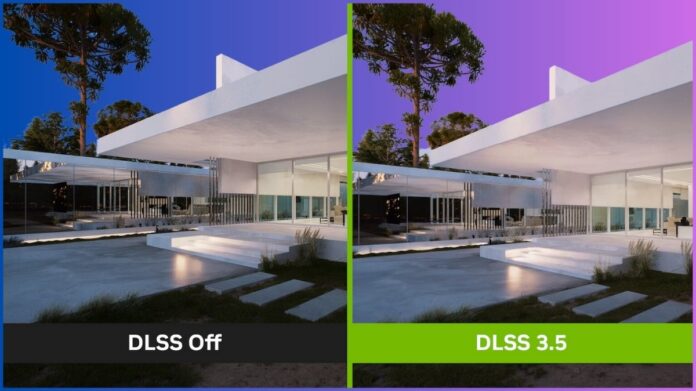Nvidia DLSS 3.5
For intense ray-traced games and applications, DLSS 3.5 with Ray Reconstruction produces ray-traced images of superior quality. This cutting edge AI-powered neural renderer increases ray-traced image quality for all GeForce RTX GPUs by using an NVIDIA supercomputer-trained AI network. Shadows, reflections, and global illumination are improved, making the game more realistic and immersive.
A Light Ray
By creating physically accurate reflections, refractions, shadows, and indirect lighting, ray tracing is a rendering technique that can faithfully mimic the illumination of a scene and its objects. By following the path of light from the view camera, which determines the view into the scene through the 2D viewing plane, out into the 3D scene, and back to the light sources, ray tracing creates computer graphics images. For example, reflections are produced when rays hit a mirror.

It is the digital counterpart of real-world objects that are lit up by light beams and the path that light takes from the viewer’s eye to the objects that light interacts with. Ray tracing is that.
It takes a lot of processing power to simulate light in this way shooting rays for each pixel on the screen even for offline renderers that compute scenes over the period of several minutes or hours. Instead, to obtain a representative sample of the illumination, reflectivity, and shadowing of the scene, ray samples fire a small number of rays at different points throughout the picture.
There are restrictions, though. The result is a noisy, pixelated, and gapped image that can be used to determine the desired ray trace of the scene. Hand-tuned denoisers employ two distinct techniques to fill in the missing pixels that weren’t ray traced: temporally gathering pixels over a number of frames and spatially interpolating them to blend adjacent pixels together. This procedure creates a ray-traced image from the noisy raw output.
This makes the development process more complicated and expensive, and also lowers the frame rate in heavily ray-traced games when several denoisers are running at once to produce various lighting effects.
With Nvidia DLSS 3.5 Ray Reconstruction, an AI-powered neural network trained on an NVIDIA supercomputer produces better-quality pixels between the sampled rays. In order to use temporal and spatial data more intelligently, it distinguishes between various ray-traced effects and preserves high frequency information for upscaling of higher quality. Additionally, it recreates in-game lighting patterns it has identified from its training data, such as ambient occlusion or global illumination.
One excellent example of Ray Reconstruction in action is Portal using RTX. The denoiser finds it difficult to recreate the dynamic shadowing with the fan moving while DLSS is turned off.
When Nvidia DLSS 3.5 and Ray Reconstruction are enabled, the AI-trained denoiser learns specific patterns linked to shadows and maintains image stability, collecting precise pixels and combining adjacent pixels to produce reflections of superior quality.
Deep Gaming and Deep Learning
DLSS performance is multiplied by AI graphics innovations such as Ray Reconstruction. The main component of DLSS, Super Resolution, reconstructs native-quality images by sampling several lower resolution images and using motion information and feedback from earlier frames. High visual quality is achieved without compromising gameplay.
With the release of DLSS 3, Frame Generation which improves performance by utilising AI to analyse surrounding frames’ data and forecast the appearance of the next generated frame was introduced. After that, these created frames are sandwiched between rendered frames. When DLSS Super Resolution is combined with the frames produced by DLSS, DLSS 3 can use AI to reconstruct seven-eighths of the pixels that are displayed, increasing frame speeds by up to four times when DLSS is not used.
Even in situations where the CPU is the game’s bottleneck, DLSS Frame Generation can increase frame rates since it is post-processed that is, applied to the GPU after the main render.
Features of Nvidia DLSS 3.5
Even better image generation
Ray tracing is a key component of Nvidia DLSS 3.5‘s emphasis on enhancing image quality, and this direction may be pursued in later iterations. It is possible that even at reduced resolutions, DLSS will produce images that are identical to native resolution.
Support for increasingly sophisticated rendering methods
As video games incorporate more intricate rendering methods, such as global illumination and ray tracing, DLSS may develop to effectively support these methods. This might enable breathtaking images without compromising functionality.
Integration of AI in game creation
AI is becoming more and more significant in the game development process. In order to help creators optimise their games for DLSS and guarantee the optimum speed and visual quality, DLSS may eventually integrate with AI technologies.
DLSS for VR applications
VR gaming is growing in popularity, however it might be difficult to render VR games at high resolutions. To enhance performance and resolution, DLSS might be modified for virtual reality, resulting in more immersive and seamless VR experiences.
More precise developer controls
With Nvidia DLSS 3.5, game developers have greater influence over how DLSS functions in their creations. If this pattern persists, developers will have much more flexibility to customise DLSS to the unique requirements of their games.
These are merely forecasts; the direction that Nvidia takes in developing the technology and future developments in technology will determine how DLSS develops. But Nvidia DLSS 3.5 bodes well for an era of PC gaming with excellent performance and breathtaking graphics.
FAQS
What is DLSS 3.5?
Nvidia’s Deep Learning Super Sampling (DLSS) technology was updated in September 2021 with the release of DLSS 3.5. It makes use of machine learning to enhance the graphics quality and performance of games particularly those that employ ray tracing.


